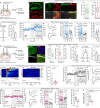This is a preprint.
Norepinephrine Signals Through Astrocytes To Modulate Synapses
- PMID: 38826209
- PMCID: PMC11142048
- DOI: 10.1101/2024.05.21.595135
Norepinephrine Signals Through Astrocytes To Modulate Synapses
Update in
-
Norepinephrine signals through astrocytes to modulate synapses.Science. 2025 May 15;388(6748):776-783. doi: 10.1126/science.adq5480. Epub 2025 May 15. Science. 2025. PMID: 40373122
Abstract
Locus coeruleus (LC)-derived norepinephrine (NE) drives network and behavioral adaptations to environmental saliencies by reconfiguring circuit connectivity, but the underlying synapse-level mechanisms are elusive. Here, we show that NE remodeling of synaptic function is independent from its binding on neuronal receptors. Instead, astrocytic adrenergic receptors and Ca2+ dynamics fully gate the effect of NE on synapses as the astrocyte-specific deletion of adrenergic receptors and three independent astrocyte-silencing approaches all render synapses insensitive to NE. Additionally, we find that NE suppression of synaptic strength results from an ATP-derived and adenosine A1 receptor-mediated control of presynaptic efficacy. An accompanying study from Chen et al. reveals the existence of an analogous pathway in the larval zebrafish and highlights its importance to behavioral state transitions. Together, these findings fuel a new model wherein astrocytes are a core component of neuromodulatory systems and the circuit effector through which norepinephrine produces network and behavioral adaptations, challenging an 80-year-old status quo.
Conflict of interest statement
Competing interests: Authors declare that they have no competing interests.
Figures




References
-
- Berridge C. W., Waterhouse B. D., The locus coeruleus-noradrenergic system: modulation of behavioral state and state-dependent cognitive processes. Brain Research Reviews 42, 33–84 (2003). - PubMed
Publication types
Grants and funding
LinkOut - more resources
Full Text Sources
Miscellaneous
